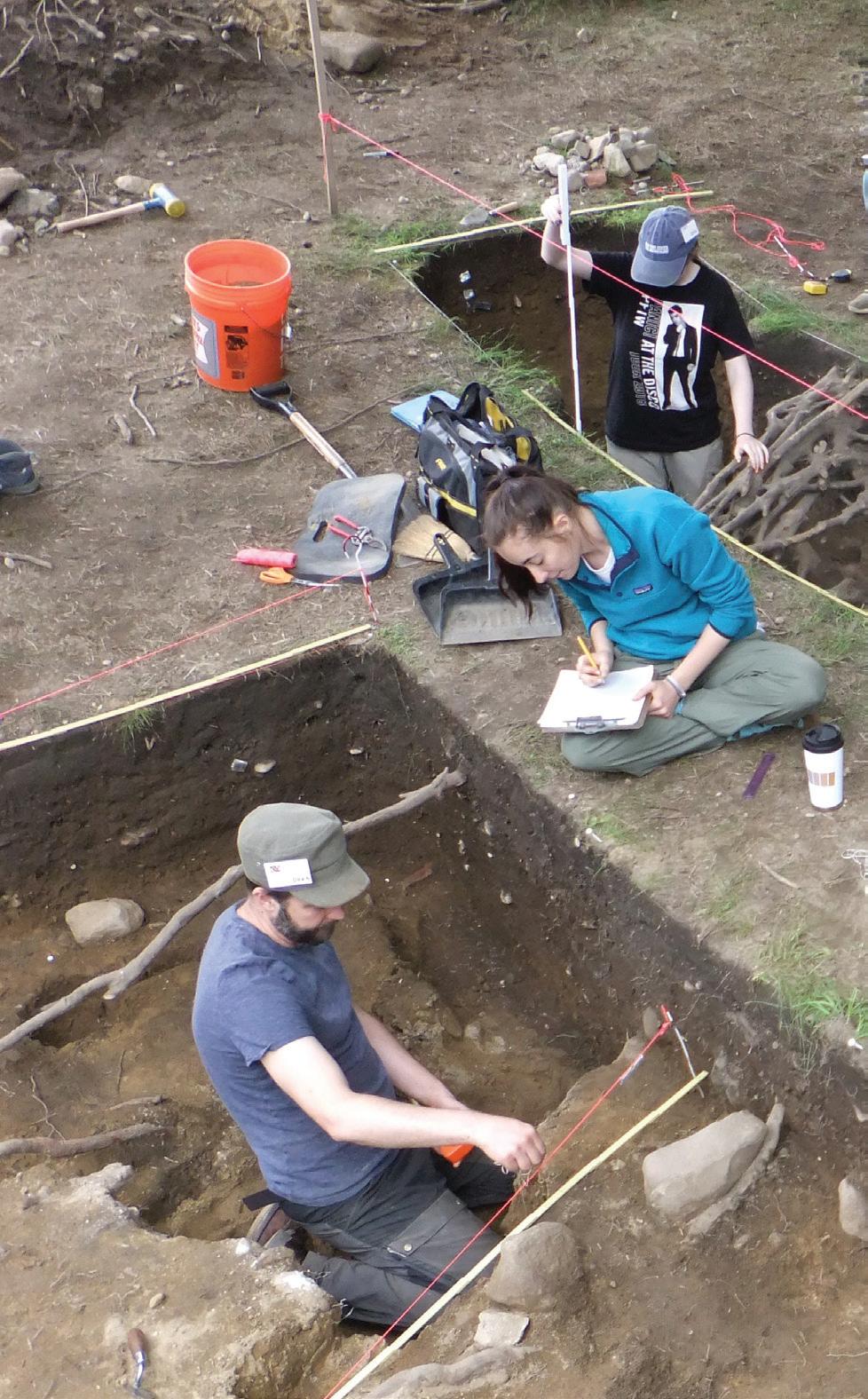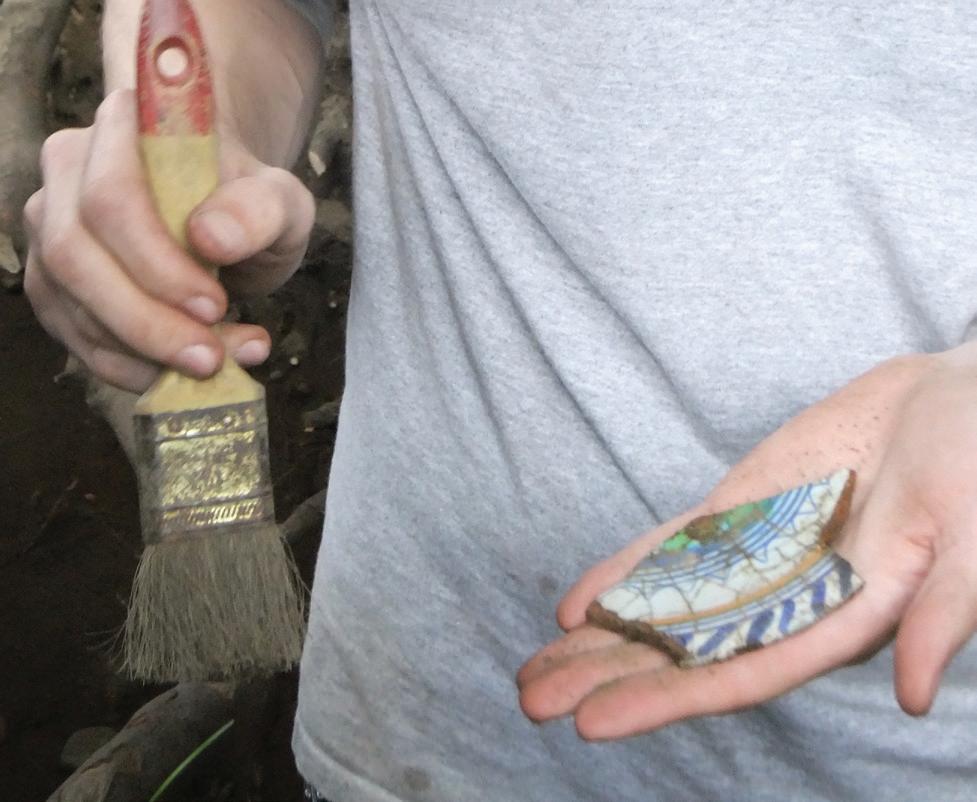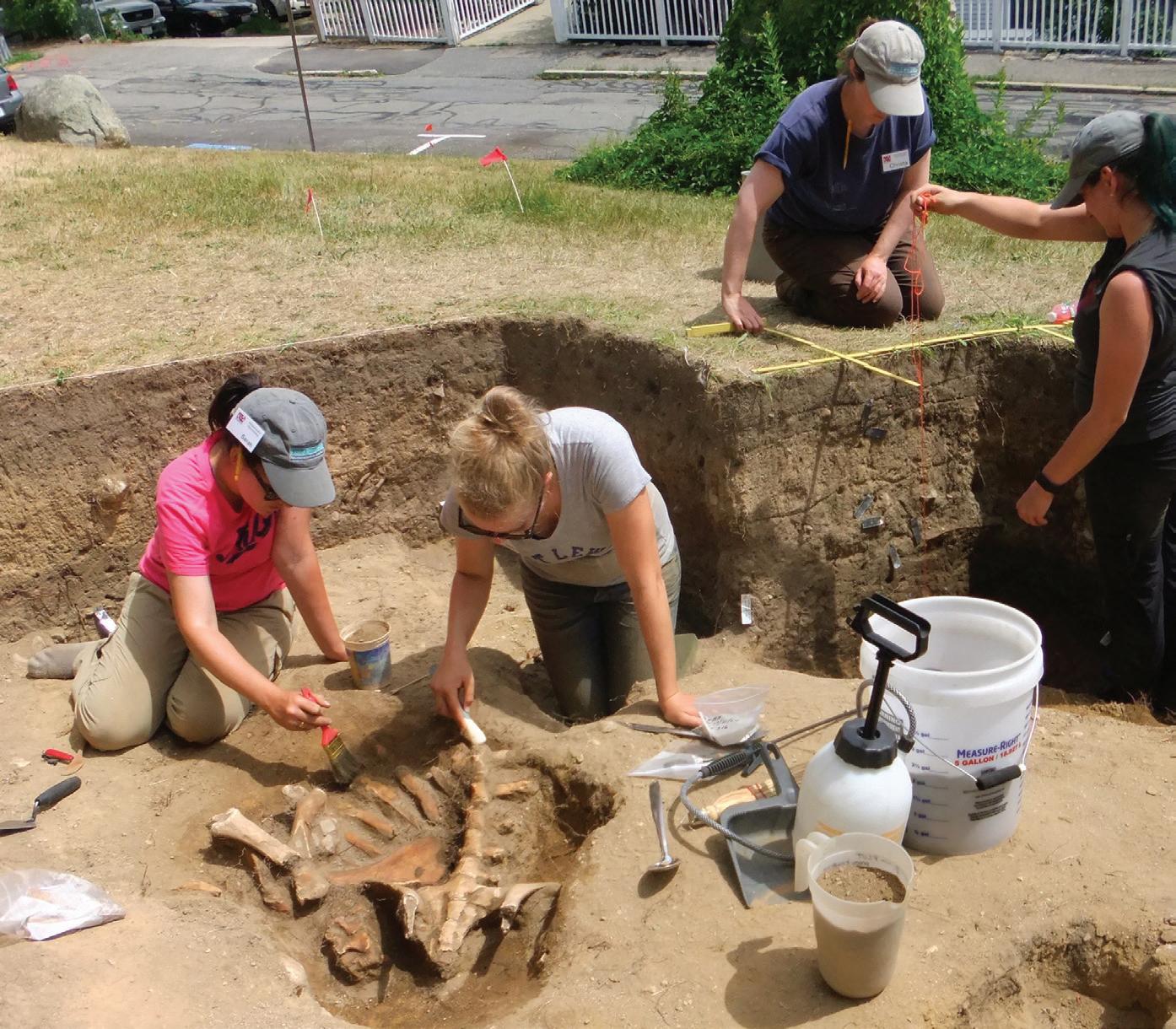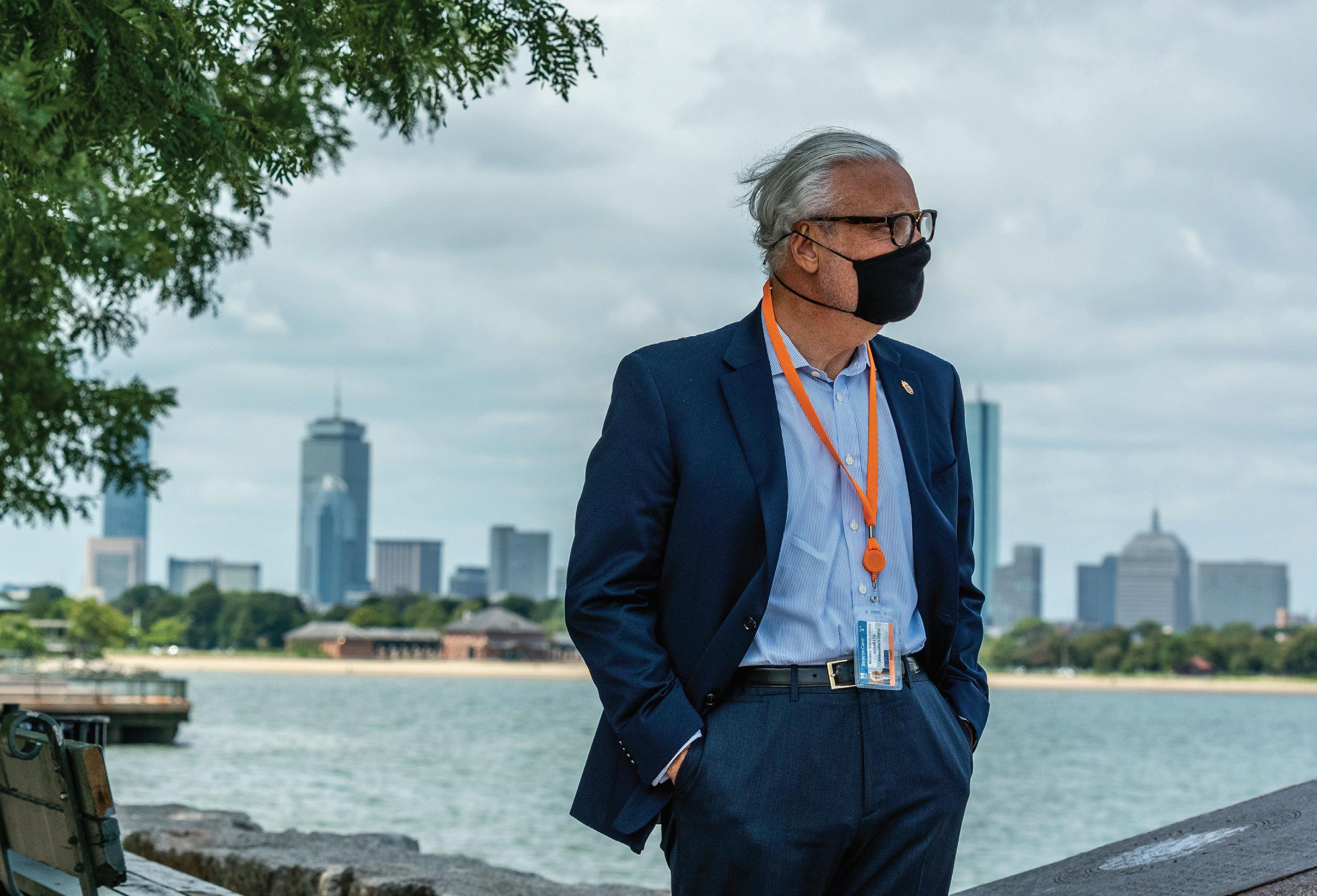
6 minute read
At the Site of the First Thanksgiving
UMass Boston Archaeologists Find the Pilgrims’ Original Compound and Offer New Insights into Relations Between English Settlers and Wampanoag.
By Colleen Locke
Four hundred years after the first Thanksgiving—a three-day harvest feast celebrated in 1621 by a band of desperately struggling English settlers and a group of neighboring native Wampanoag— it remains shrouded in many mysteries. Where exactly did the feast take place? What were relations between the colonists and native inhabitants like? Now, as the 400th anniversary of the first Thanksgiving draws near, UMass Boston researchers are starting to provide answers.
In 2013, David Landon, associate director of UMass Boston’s Andrew Fiske Memorial Center for Archaeological Research, launched an archaeological investigation into those questions with the cooperation of the Town of Plymouth and Plimoth Plantation, a living museum recreating life in the 17th-century settlement. He began with a search for evidence of the palisade that surrounded the original settlement where the first Thanksgiving probably took place. No one knew exactly where it had been built.
“Historical accounts of Plymouth put the top of Burial Hill as the location of the first fort and meeting house,” Landon said. “There are no maps from the time period, and the first map that puts any of the features of the original settlement on the ground isn’t until the 1870s. But there is an 1870s map that marks a location on Burial Hill. It says, ‘site of the first fort and meeting house.’”
Graduate students from UMass Boston and around the country have been participating in an archaeological dig in search of the original settlement every summer for five weeks for the past seven years. The dig focused in two areas on Burial Hill separated by an 1830s burial vault. One of the goals of the project was to locate evidence of the fortification in time for the 400th anniversary of the city of Plymouth in fall 2020. The fast-approaching deadline helps explain why graduate student Linda Seminario G’23 remembers exactly where she was last year on the day that students in UMass Boston’s Archaeological Field School found evidence of the original palisade wall built to protect the Plimoth settlement.
“I was digging in the cellar [of a 17th-century house], which is about as deep as I am tall,” recalled Seminario. “My friend whispers to me, ‘I think we found the palisade.’”
The Edge Piece
A New View of Relations Between Colonists and Natives
Elizabeth Tarulis G’20, a master’s student at the time of the discovery, said finding evidence of constructed features that have disappeared over time is different from finding tangible artifacts.
“Because soil is deposited in layers, when anything goes through those layers it’s going to disturb them, and it’s going to leave distinctive shapes that we can interpret,” Tarulis explained. “Trees, when they go through the soil, they leave behind root stains. If you put in a fence post, that leaves behind what’s called a post hole.”
It was the discovery of a series of post-hole stains in the soil that led student researchers to definitively conclude that they had found the location of the palisade wall in 2019.
“They noticed there were these darker spots that seemed to make a line, and they called Dave and [project archaeologist] Christa [Beranek] over,” Seminario remembered.
“We are the first ones to actually have found any intact sections of the settlement,” Landon said. “What I’ve said to people is since we’re digging in downtown, we’re never going to find the whole outline of the settlement. We’re just going to get little jigsaw puzzle pieces of it. With the palisade, I like to say we’ve only got a jigsaw puzzle piece, but we’ve got an edge piece.”
If the discovery of a fragment of the palisade wall helps locate the original settlement more precisely, and thus the general area where the first harvest celebration took place, other discoveries made by Landon’s team help characterize the relationship between settlers and natives.
How extensive were the encounters between the English and the Wampanoag during the earliest years of the settlement? The UMass Boston team thinks that perhaps they were more extensive than previously thought. They’ve made that assessment based on the European pottery and Wampanoag pottery found in trash pits and the yard outside the 17th-century house.
“We kind of looked closely at that association, and it really seems like the European and Native pottery were being used side by side in some of the English houses in the original settlement,” Landon said. “The artifacts of that are not super exciting to look at because we’re looking at all these tiny little broken pieces of pottery. But then we go through the process of looking at the spatial patterning and the way they occur together in specific deposits, and it gives us some interesting information about close trade relationships between the Wampanoag and the colonists.” “I think a lot of visitors coming to our museum have this idea that the Pilgrims came to an uninhabited wilderness and every so often different indigenous characters would wander through,” Jade Luiz, the curator of collections at Plimoth Plantation, said. “But in fact, what the archaeology is demonstrating is this constant communication and exchange of material goods and probably interpersonal interactions that are happening.”
Luiz says UMass Boston’s findings have informed a new exhibit installed at the beginning of the 2020 season and that visitors to Plimoth Plantation will notice the addition of Wampanoag earthenware cooking pots, called pipkins, in English hearths.
Adds Sarah Rose, the deputy director for museum education and outreach at Plimoth Plantation, “It’s just so fun when the archaeology backs up what we think we know from English accounts, and then to get the Native archaeology on top of that, the part of the story we don’t have a written record for, that gets super exciting for me, a non-archaeologist .”
As Seminario put it, “It really shifts the idea of what this moment in history looked like.”
Excavations took place in a busy downtown area of Plymouth. Next page, middle: Pottery shards found at the site. Bottom: Artifacts from the time of the original settlement were buried deep in the soil.

The location of each unearthed feature is carefully noted.


Constance the Calf

Students do the delicate work of exposing the bones of a calf that died within the compound of the first settlement. But what caused its death?
In 2014, when UMass Boston researchers began to find 17thcentury artifacts such as pottery, tins, trade beads, and musket balls, they were cautiously optimistic that they had found a location inside the walls of the first Plimoth settlement. But they weren’t sure until 2016 when they uncovered the skeleton of a calf, which students affectionately named Constance. “Because native people didn’t have domestic cattle,” said David Landon, associate director of UMass Boston’s Andrew Fiske Memorial Center for Archaeological Research, “we know that Constance lived—and died—in the confines of the original Plymouth settlement.”
“When we first uncovered the calf skeleton, we puzzled over the cause of death,” Landon continued. “Typically, when animals are eaten, the skeleton is cut up into smaller portions during butchery. In this case, we had lots of articulated parts of a single animal, showing that it was buried partially intact. When we brought all of the bones back to the lab, Anna Opishinski, one of the graduate research assistants, did a detailed ‘forensic’ analysis of the bone surfaces, looking for evidence of disease, injury, or something else that would hint at the cause of death. In this case, Anna found very small cut marks across many surfaces of the bone, showing that the animal was in fact butchered and eaten.”








